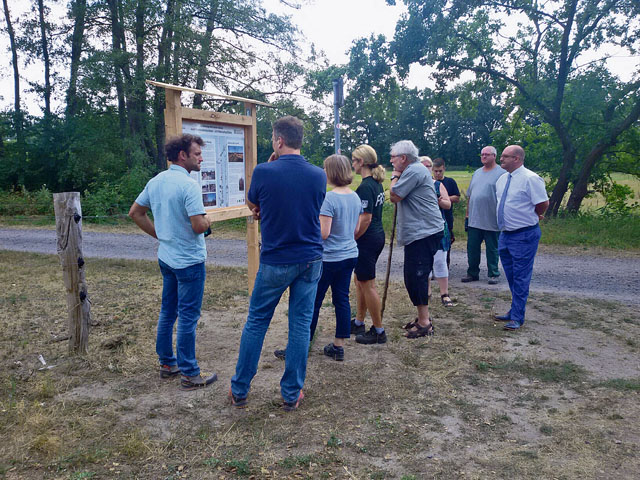
From 1963 to 1995, a U.S. Army compound on the edge of Germany’s Hassloch Forest served as a NATO air defense missile site, then later as a storage area for military vehicles.
More than 20 years after the site’s closure, representatives from the U.S. Army Garrison Rheinland-Pfalz joined members of Germany’s Upper Nature Protection Board, Lower Nature Protection Board and the Federal Agency for Real Estate Tasks, or BImA, at the former entrance gate Aug. 23 to dedicate an informational sign commemorating the successful joint U.S.-German project to environmentally restore the area.
“I closely monitored this project over the last seven years and intensively worked together with BImA Federal Forest partners, so there was always technical support from our side to include surveys and concept development,” said Johannes Haid, geographer and safety engineer with the garrison’s Directorate of Public Works Environmental Management Division at Germersheim Army Depot.
Today, the species-rich open landscape left by the military offers a home to many protected animals. The buildings have been demolished and the landscape is now permanently preserved — thanks to foresight, partnerships and funding.
After the withdrawal of the missiles in 1983, the area served as a military vehicle storage site for 12 years and large parts of the previously unsealed area were filled with gravel. No longer required operationally, in 1995 the 16-hectare area reverted back to Germany’s federal property administration as its owner.
The establishment of the preserve at the former Army site is compensation for the expansion of the nearby U.S. Army Depot at Germersheim, explained Haid. The Army upgraded the former Geinsheim site in 2010, extending the existing rare habitats and maintaining them in long-term care. To achieve this, a concept was developed in partnership with German ecological experts, and in cooperation with the BImA and nature conservation authorities.
All measures, such as the dismantling of buildings, construction of further biotopes and the 30-year maintenance of the area, are financed by the U.S. Army from funds for the expansion of the U.S. Depot Germersheim, securing long-term preservation of the unique landscape.
“As a caretaker partner, nature protection association Pollichia came on board in 2014, to ensure open grazing for zebu cattle and to determine if the use of these animals was sufficient to maintain open space or if the surfaces must be mechanically maintained,” said Haid. “The BImA is also responsible for additional compensation measures, to include the installation of nesting boxes or the construction of aquatic environments for the promotion of amphibians and dragonflies.”
An animal and plant world now inhabits the former Army site, which is known for sandy grasslands, dwarf shrub heaths and whistling grass meadows. This biodiversity developed through years of human involvement, explained Haid, but the forest eventually returned to the open land. A pioneer forest of birch and non-native, invasive tree species such as late-flowering bird cherry and vinegar trees are growing, which is home to a far less abundant flora and fauna than the open land area.
Today, the Geinsheim site is within the European Union’s Bird Sanctuary, and is home to protected species such as red-backed shrikes, wrynecks and gray-headed woodpeckers. Other rare species such as crested newt, praying mantis and green beach insect also find this a suitable habitat.
Free access to the area is not permitted due to grazing, but it is possible to visit the former Geinsheim site by arrangement with BImA.


